简爱女性主义解读
《女性主义视角下的《简爱》解读》
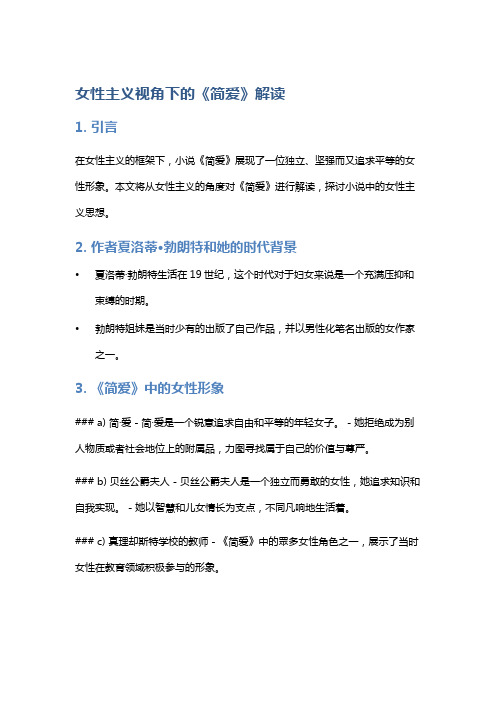
女性主义视角下的《简爱》解读1. 引言在女性主义的框架下,小说《简爱》展现了一位独立、坚强而又追求平等的女性形象。
本文将从女性主义的角度对《简爱》进行解读,探讨小说中的女性主义思想。
2. 作者夏洛蒂·勃朗特和她的时代背景•夏洛蒂·勃朗特生活在19世纪,这个时代对于妇女来说是一个充满压抑和束缚的时期。
•勃朗特姐妹是当时少有的出版了自己作品,并以男性化笔名出版的女作家之一。
3. 《简爱》中的女性形象### a) 简·爱 - 简·爱是一个锐意追求自由和平等的年轻女子。
- 她拒绝成为别人物质或者社会地位上的附属品,力图寻找属于自己的价值与尊严。
### b) 贝丝公爵夫人 - 贝丝公爵夫人是一个独立而勇敢的女性,她追求知识和自我实现。
- 她以智慧和儿女情长为支点,不同凡响地生活着。
### c) 真理却斯特学校的教师 - 《简爱》中的眾多女性角色之一,展示了当时女性在教育领域积极参与的形象。
4. 女性主义主题### a) 婚姻与社会地位 - 《简爱》揭示了19世纪初期妇女所面临的社会压力和对婚姻的依赖。
- 小说通过简·爱对抗家庭和社会对她地位限制来表达女性主义思想。
### b) 自由与独立 - 《简爱》强调了女性追求自由和独立,并反抗受到男性支配的社会观念。
- 简·爱在小说中表达了她与罗切斯特结合不是为了被人控制,而是为了寻找真正的平等关系。
5. 反思与启示•夏洛蒂·勃朗特通过《简爱》呼唤了当时妇女争取自由和平等的呼声。
•《简爱》中的女性形象提醒我们,妇女应争取独立、追求平等,不被社会对性别的刻板印象束缚。
6. 结论通过女性主义视角解读《简爱》,我们看到勃朗特姐妹在当时极度保守的社会中展现了坚定与勇敢。
小说中的女性形象和主题加深了人们对于婚姻、自由和独立等议题的思考,成为影响着后代女性解放运动的经典之作。
注:本篇文档共计317个字,需要进行补充。
女性的自我意识与反抗:《简爱》的女性主义解析

女性的自我意识与反抗:《简爱》的女性主义解析引言《简爱》是英国作家夏洛蒂·勃朗特的经典小说,被广泛认为是19世纪以来最重要的女性主义文学之一。
本文将探讨其中所呈现的女性自我意识和反抗,并对其进行女性主义解析。
自我意识的觉醒在《简爱》中,主人公简·爱通过她的成长与经历逐渐觉醒了自我意识。
从小被亲戚视为家里“多余”的她,在叔叔家遭受虐待和不公平待遇。
然而,这些不幸并没有打击她内心深处坚强独立的本能。
在洛河学校时期,简展现了她追求知识、追求尊严、追求平等的决心。
她坚信每个人都应该有机会追求自己想要的生活。
反抗社会期望社会对于妇女角色的期望往往限制了她们发展和实现个人价值。
然而,《简爱》中的女性角色都在不同程度上反抗了这种期望。
简对于约翰·韦尔奇的求婚说不,因为她不愿意牺牲自己的独立和尊严。
而后,她在苔丝中找到了心灵的伴侣和相互尊重的关系。
简爱通过与罗切斯特先生之间的对话、互动和婚姻选择,展现了自己坚守内心价值观的勇气和决心。
女性主义的探索《简爱》被广泛解读为一部女性主义小说,因为它涉及并讨论了很多女性主义议题。
作者夏洛蒂·勃朗特通过塑造简这个富有个人觉醒和反抗精神的角色,揭示了当时社会对于女性存在的束缚和限制。
同时,小说也探讨了婚姻中女性地位的问题,提醒女性要保持自我独立,并追求属于自己真正幸福。
结论《简爱》是一部充满力量与觉醒的女性主义文学作品。
通过主人公简·爱的经历,我们看到了一个普通女子如何通过坚守自身价值观,最终获得独立和幸福。
这部小说不仅揭示了当时社会对女性的束缚,也启发了无数读者思考女性自我意识与反抗的重要性。
总之,《简爱》的女性主义解析不仅帮助我们理解作品本身,也为我们思考当代社会中女性所面临的问题提供了力量和启示。
女性主义视角下的文学作品简爱中的自我价值与社会角色

女性主义视角下的文学作品简爱中的自我价值与社会角色简爱是英国作家夏洛蒂·勃朗特的代表作之一,被广泛认为是一部重要的女性主义小说。
本文从女性主义视角探讨《简爱》中主人公简·爱的自我价值与社会角色。
一、自我价值的探索在《简爱》中,简·爱是一个有思想、有个性且勇敢追求自由的女性形象。
从小孤儿院到罗沃德庄园的家庭教师,简经历了从无权力到有权力的转变,也逐渐意识到自己的自我价值。
她不满足于传统女性角色的束缚,通过学习和读书来充实自己,以追求自我实现和独立。
二、婚姻与自我认同婚姻是《简爱》中的重要主题,也是女性角色的必经之路。
然而,简·爱并不屈从于社会对女性的期望,她坚持婚姻应该基于平等和爱情,而不仅仅是为了满足社会的期待。
她拒绝了罗切斯特先生的求婚,因为她意识到只有在互相尊重和平等的基础上,她才能真正找到自我认同。
三、社会角色的挑战《简爱》中的社会角色对女性来说是具有挑战性的,女性往往被限制在家庭和婚姻中。
然而,简·爱不愿意被局限在这种角色中,她渴望得到自由和独立。
她不顾传统的观念,追求自己内心的真实,不断挑战现存的社会规范。
四、女性主义思想的展现女性主义的核心思想是追求性别平等和女性独立。
《简爱》通过描述简·爱的经历和思想,传达了女性在传统社会中争取自由和平等的力量。
简·爱勇敢地追求自己的梦想,坚持自己的价值观,并最终实现了自我的解放。
五、反思和启示《简爱》以其女性主义的立场,呼唤人们关注女性的自我认同和价值。
作为女性,我们应该学习简·爱的勇气和坚持,追求自己的梦想,不被社会角色所束缚。
同时,作为社会的一份子,我们应该摒弃传统的性别观念,为建设一个性别平等的社会而努力。
结论:总而言之,《简爱》这部作品在女性主义视角下展现了主人公简·爱的自我价值和对社会角色的挑战。
通过她的经历和思想,小说向读者传递了追求自由、追求平等的重要价值观。
《简爱》的女性主义思想分析
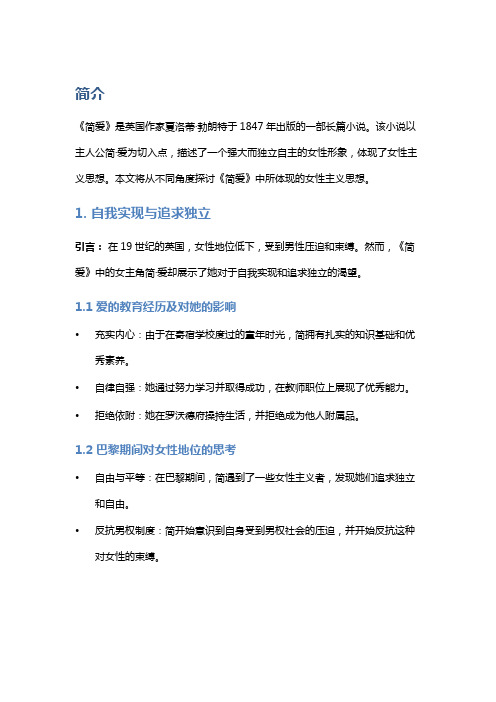
简介《简爱》是英国作家夏洛蒂·勃朗特于1847年出版的一部长篇小说。
该小说以主人公简·爱为切入点,描述了一个强大而独立自主的女性形象,体现了女性主义思想。
本文将从不同角度探讨《简爱》中所体现的女性主义思想。
1. 自我实现与追求独立引言:在19世纪的英国,女性地位低下,受到男性压迫和束缚。
然而,《简爱》中的女主角简·爱却展示了她对于自我实现和追求独立的渴望。
1.1 爱的教育经历及对她的影响•充实内心:由于在寄宿学校度过的童年时光,简拥有扎实的知识基础和优秀素养。
•自律自强:她通过努力学习并取得成功,在教师职位上展现了优秀能力。
•拒绝依附:她在罗沃德府操持生活,并拒绝成为他人附属品。
1.2 巴黎期间对女性地位的思考•自由与平等:在巴黎期间,简遇到了一些女性主义者,发现她们追求独立和自由。
•反抗男权制度:简开始意识到自身受到男权社会的压迫,并开始反抗这种对女性的束缚。
2. 爱情观与婚姻观的批判引言:女性主义思想也体现在对爱情观和婚姻观的批判上。
在《简爱》中,女主角对传统的爱情观和婚姻观提出了质疑。
2.1 对罗切斯特的挣扎•年龄差异:简担心自己与罗切斯特之间存在年龄不同带来的不平等。
•社会地位与财富:她认为社会地位和财富并不应该是决定两人关系的因素,更加重视感情的平等。
•爱情需建立在平等基础上:简坚持认为任何关系都需要建立在平等、尊重和相互理解的基础上。
2.2 推翻传统婚姻模式•拒绝接受婚姻的依附性质:简清楚地表达出她不愿意成为一个男人的附属品。
•独立与事业:她更加注重个人价值和追求,并且决心要过着一个独立自由的生活。
3. 自我认同与自主选择引言:女性主义思想强调女性的自主权利,包括自我认同和自主选择。
在《简爱》中,简·爱展现了这种思想。
3.1 追求真实的自我•拒绝伪装:简坚持保持真实的形象,在面对社会审视时也毫不掩饰自己。
•自我尊重与尊重他人:她坚守原则,不允许任何人对自己进行控制,同时也尊重他人的选择。
《简爱》中的女性主义观点
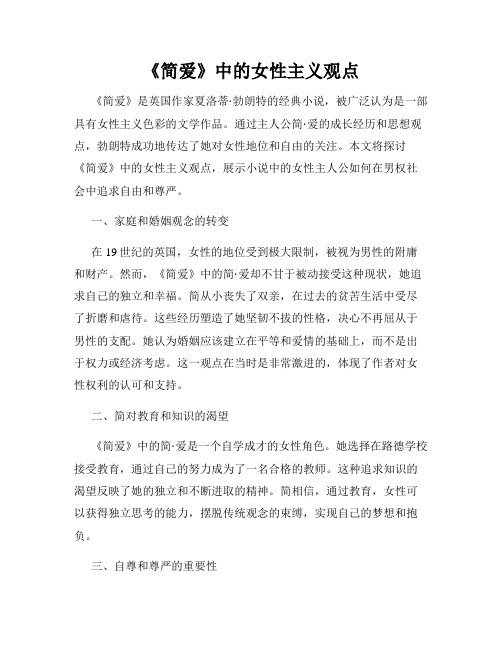
《简爱》中的女性主义观点《简爱》是英国作家夏洛蒂·勃朗特的经典小说,被广泛认为是一部具有女性主义色彩的文学作品。
通过主人公简·爱的成长经历和思想观点,勃朗特成功地传达了她对女性地位和自由的关注。
本文将探讨《简爱》中的女性主义观点,展示小说中的女性主人公如何在男权社会中追求自由和尊严。
一、家庭和婚姻观念的转变在19世纪的英国,女性的地位受到极大限制,被视为男性的附庸和财产。
然而,《简爱》中的简·爱却不甘于被动接受这种现状,她追求自己的独立和幸福。
简从小丧失了双亲,在过去的贫苦生活中受尽了折磨和虐待。
这些经历塑造了她坚韧不拔的性格,决心不再屈从于男性的支配。
她认为婚姻应该建立在平等和爱情的基础上,而不是出于权力或经济考虑。
这一观点在当时是非常激进的,体现了作者对女性权利的认可和支持。
二、简对教育和知识的渴望《简爱》中的简·爱是一个自学成才的女性角色。
她选择在路德学校接受教育,通过自己的努力成为了一名合格的教师。
这种追求知识的渴望反映了她的独立和不断进取的精神。
简相信,通过教育,女性可以获得独立思考的能力,摆脱传统观念的束缚,实现自己的梦想和抱负。
三、自尊和尊严的重要性在男权社会中,女性被认为是弱者,缺乏自主权和尊严。
然而,简·爱通过坚持自己的原则和价值观,展现了女性追求尊严和自由的勇气。
她独立地生活,拒绝成为男性的附庸,坚持自己的人生选择。
简所表达的女性主义观点,强调女性应该被当作独立的个体被尊重,而不仅仅是男性的附属品。
四、性别和社会地位的反思《简爱》中的女性主义观点还涉及到对性别和社会地位的质疑。
简意识到,社会对于男性和女性的角色和期望是不公正的。
她拒绝接受传统的性别角色和社会层级,坚持相信每个人应该被平等对待,不论其性别、身份或地位。
她通过与罗切斯特先生的关系,展示了女性在争取平等权利和争议的过程中的勇气和决心。
总之,夏洛蒂·勃朗特的《简爱》充满了女性主义的观点。
小说《简爱》中的女权主义解读

小说《简爱》中的女权主义解读《简爱》是英国女作家夏洛特·勃朗特的经典之作。
女主人公简爱形象的原型就是取自作者本人,小说的大部分情节也都是源自作者真实的生活经历,虽不完全相似,但通过对夏洛特经历的了解可以帮助我们更好地理解简爱这一文学形象,其中暗含的女权主义思想从作者的生活中也可以找到端倪。
一、“女权主义”概要阐释女权主义内容广泛,涉及经济、政治等多个领域,最初是女性为捍卫自己的选举权而不断抗争、获得平等政治权的历程。
而后随着时代的发展其被赋予了更为丰富的内涵,泛指女性为了追求平等权利、实现男女平等而采取的一切努力。
当时文学作品中涉及女权主义这一领域的并不多,这主要是因为处于19世纪的大背景下,社会上等级森严,女子的地位十分低下,往往受到社会的歧视,女性形象在作品中通常被定位为纤纤淑女,是为景仰男人而存在的附属角色,存在感较弱,本身没有什么个性可言,语言表达和行为上也并不是十分突出。
而《简爱》的问世,打破了这种沉闷的千篇一律的文学创作市场,其对“女权主义”的不加掩饰的表现在当时显得特立独行,虽受到两极化的评价,但其对女权主义应用于文学领域以及解放妇女思想、形成独立自主精神的贡献是不容忽视的。
二、夏洛特与《简爱》夏洛特生活在19世纪中前期的英国,幼年时夏洛特失去了两个亲爱的姐姐,被送到了姨妈家。
此时的夏洛特已经意识到自己成为了家里最大的孩子,承担着照顾弟弟妹妹的职责,只有自己变得强大才能给家人带来好的生活。
此后为了接受更好的教育,夏洛特进入伍勒小姐的学校学习,多年后在布鲁塞尔学习和任教期间,她迷恋上了自己的老师——有妇之夫埃热先生并多次写信表达爱慕之情,可是这种相差悬殊的爱慕注定无果而终。
伤心的她重返哈沃斯,此后几年虽然完成了《简爱》的出版并获得了极大的成功,但家人离去、父亲病重仍给了她沉重的打击,38岁时夏洛特嫁给了一位牧师,可幸福的生活仅持续了一年,夏洛特便因病离世,年仅39岁。
简爱这一文学形象既是夏洛特本人的部分写照,也蕴含了夏洛特的憧憬与期待。
解读《简·爱》中的女权主义
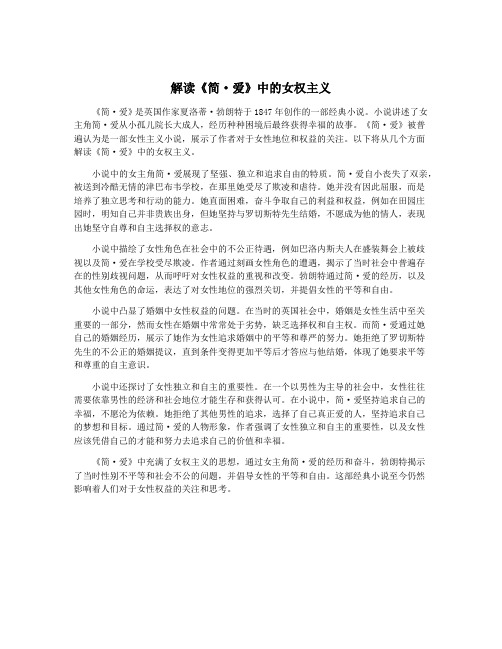
解读《简·爱》中的女权主义《简·爱》是英国作家夏洛蒂·勃朗特于1847年创作的一部经典小说。
小说讲述了女主角简·爱从小孤儿院长大成人,经历种种困境后最终获得幸福的故事。
《简·爱》被普遍认为是一部女性主义小说,展示了作者对于女性地位和权益的关注。
以下将从几个方面解读《简·爱》中的女权主义。
小说中的女主角简·爱展现了坚强、独立和追求自由的特质。
简·爱自小丧失了双亲,被送到冷酷无情的津巴布韦学校,在那里她受尽了欺凌和虐待。
她并没有因此屈服,而是培养了独立思考和行动的能力。
她直面困难,奋斗争取自己的利益和权益,例如在田园庄园时,明知自己并非贵族出身,但她坚持与罗切斯特先生结婚,不愿成为他的情人,表现出她坚守自尊和自主选择权的意志。
小说中描绘了女性角色在社会中的不公正待遇,例如巴洛内斯夫人在盛装舞会上被歧视以及简·爱在学校受尽欺凌。
作者通过刻画女性角色的遭遇,揭示了当时社会中普遍存在的性别歧视问题,从而呼吁对女性权益的重视和改变。
勃朗特通过简·爱的经历,以及其他女性角色的命运,表达了对女性地位的强烈关切,并提倡女性的平等和自由。
小说中凸显了婚姻中女性权益的问题。
在当时的英国社会中,婚姻是女性生活中至关重要的一部分,然而女性在婚姻中常常处于劣势,缺乏选择权和自主权。
而简·爱通过她自己的婚姻经历,展示了她作为女性追求婚姻中的平等和尊严的努力。
她拒绝了罗切斯特先生的不公正的婚姻提议,直到条件变得更加平等后才答应与他结婚,体现了她要求平等和尊重的自主意识。
小说中还探讨了女性独立和自主的重要性。
在一个以男性为主导的社会中,女性往往需要依靠男性的经济和社会地位才能生存和获得认可。
在小说中,简·爱坚持追求自己的幸福,不愿沦为依赖。
她拒绝了其他男性的追求,选择了自己真正爱的人,坚持追求自己的梦想和目标。
浅析《简爱》中的女性主义思想

目录摘要 (1)关键词 (1)Abstract (1)前言 (2)一、作者女性主义思想的产生 (2)二、《简爱》中的女性主义思想 (3)(一)突破相貌美丽的俗套 (3)(二)顽强、独立、自尊、自爱 (4)(三)政治、经济、人格平等的新式爱情观 (5)结语 (7)参考文献: (8)浅析《简爱》中的女性主义思想学生姓名:学号:文学院汉语言专业指导老师:职称:摘要:在现代社会女性的地位普遍有所提高,但由于受传统文化观念的影响,现实社会中仍然存在着男女不平等的现象。
而夏洛蒂·勃朗特的《简爱》是西方女性主义的一部代表作,本文将对作者女性主义思想产生的原因以及简爱中的女性主义思想进行论述,她的女性主义思想主要是通过他哦破美丽的俗套,独立、顽强、自尊、自爱以及政治、经济平等的新式爱情观来体现,通过论述使我们加深对女性主义思想的认识,从而促进我国女性自我意识的觉醒与提高。
关键词:女性主义思想;独立;顽强;新式爱情观Abstract:The status of women in modern society in general has increased, but due to the influence of traditional cultural values, the real world there are still inequality between men and women. The Charlotte • Bronte's "Jane Eyre" is a masterpiece of Western feminism, this article will be thinking of the causes of feminism and feminist Jane thinking in the discourse, and her feminist ideas mainly through his Oh, beautiful breaking stereotypes, independent, stubborn, self-esteem, self-love, and political and economic equality to reflect the new concept of love, through the discussion to deepen our understanding of feminist ideology.Keywords:Feminist ideas;Independence;Stubborn;New Concept of Love前言随着女性地位的提高,女性主义也越来越被受到重视,所谓女性主义,归结起来就是:在全人类实现男女平等。
女性主义视角下的《简爱》:性别与自我意识的探索

女性主义视角下的《简爱》:性别与自我意识的探索引言《简爱》是英国作家夏洛蒂·勃朗特的经典小说,被视为女性文学中的杰作之一。
本文将以女性主义的视角来解读这部小说,探讨其中揭示的性别与自我意识问题。
第一章:女性在维多利亚时代的困境在分析《简爱》之前,先介绍一下维多利亚时代女性所面临的困境。
该时期,社会对妇女有着严格限制和传统观念,妇女通常被认为只适合从事家务劳动,并被剥夺了接受教育和追求职业发展的机会。
这种社会背景对于理解小说中主人公简·爱的成长背景至关重要。
第二章:简·爱的成长历程本章将详细探讨简·爱作为一个具有女性意识的角色在小说中的成长历程。
无论是在她童年时期受到虐待和歧视,还是成年后进入罗切斯特府邸工作,她都经历了一系列的挫折和困境,但同时也不断探索和坚持自己的真实内心。
简·爱逐渐成为一个独立自主、坚强勇敢的女性形象,展现出她对权力、自由和平等的追求。
第三章:性别角色与女性解放在本章中,将重点关注小说中男女角色之间的互动和性别角色意识。
罗切斯特府邸成为了一个象征性别权力关系的场所。
通过人物之间的相互作用和对话,可以看到作者对传统男权社会中女性地位的批判,并倡导女性争取解放和平等。
同时,简·爱作为主人公也代表了女性通过拒绝被定型化来寻找自我认同和自由。
第四章:小说影响与时代意义最后一章将讨论《简爱》对于当时社会以及现代女权运动的影响与时代意义。
虽然该小说首发时间已有甚久,但对于当下仍是具有重要价值的文学作品。
它给予读者反思维多利亚时代妇女处境,并启发了后来的女性主义运动。
结论通过对《简爱》的女性主义视角解读,我们可以更好地理解小说中关于性别与自我意识问题所传达的思想。
它不仅是一部文学作品,更是对当时社会压迫和女性权益呼声的深刻揭示。
女性主义在《简爱》中的追求与反抗

女性主义在《简爱》中的追求与反抗简介《简爱》是英国作家夏洛蒂·勃朗特于19世纪中期创作的一部经典文学作品,也是女性主义文学的重要代表之一。
本文将探讨《简爱》中女性主义的观点、角色塑造以及对社会和个人解放的追求与反抗。
女性主义观点的呈现1.自我认同:小说主人公简·爱通过她的自述揭示了自己的自我认同,并且对传统女性角色有所质疑。
2.教育权利:在小说中,简·爱不愿被束缚在男性主导的教育体制下,表现出对教育平等权利的渴望。
3.社会地位:通过Jane在寄宿学校工作以及成为罗德斯一家庄园管家后,她获得了独立、自给自足、并享受一定社会地位的机会。
这彰显了女性追求平等和独立地位之意识。
角色塑造与反抗形式1.简·爱:坚强独立的女性形象。
她追求自由、主权,不愿受到男权社会的束缚,并对不公平对待展开反抗。
2.罗切斯特先生:与其它男性角色相比,他对简·爱的才华和智慧给予充分的认可,并接受她,并成为她的伴侣。
这在一定程度上展示了女性拥有独立思考力和发声权之重要性。
2.简·爱与约翰·里弗斯:约翰将简视为虚弱而处理她,试图让她屈从于传统女性角色。
然而素来坚毅的简在小说中最终提出反抗,并坚决拒绝了他。
对社会解放的追求1.反对婚姻压迫:小说揭示了19世纪女性在婚姻中可能面临厌倦、束缚和剥夺人格尊严等情境,呼吁真实、平等和共同理解构建婚姻制度。
2.社会经济地位:通过Jane作为一个工作女性所获得的经济地位及相应机遇,探讨女性积极参与社会经济活动,赢得自主权力的重要性。
对个人解放的追求1.启示和精神独立:通过简·爱这一角色对社会因素和个人内心思想的探索,小说强调了女性的独立思考能力以及如何通过坚定意志获得情感自由。
2.爱情与自我实现:小说中虽然描述了简爱与罗切斯特先生之间的浪漫关系,但重点仍是强调女性不应将幸福完全寄托于爱情,而是应该主导自己的命运并追求个人价值实现。
解读《简·爱》中的女权主义

解读《简·爱》中的女权主义《简·爱》是英国作家夏洛蒂·勃朗特于1847年出版的一部经典小说,被誉为英国文学史上的经典之作。
本文将从女权主义的角度对《简·爱》中的女性形象和社会地位进行解读,探讨小说中所体现的女性主义精神和价值观。
我们来看一下《简·爱》中的主人公简·爱。
简·爱是一个坚强、独立、聪明的女性,她在小说中展现了对自己生活的控制和追求自由的渴望。
从小被遗弃的她经历了孤儿院的苦难,但并没有因此麻痹自己的心。
她拒绝成为依附于他人的受害者,而是努力追求自己的梦想和独立的生活。
这种坚韧不拔的性格,让她成为了一个非常有魅力的女性形象,也正是女性主义者所推崇的女性价值观。
在小说中,简·爱对家庭和婚姻的态度也体现了女性主义的精神。
她拒绝了一个并没有真正爱她的男人的求婚,因为她不愿意牺牲自己的尊严和自由。
她追求平等和尊重的婚姻关系,而不是被动地接受命运的安排。
这种拒绝牺牲自己的权利和尊严来维持婚姻的态度,体现了女权主义者对婚姻和家庭关系的重新思考,强调了女性在家庭关系中的平等地位和尊严。
《简·爱》中描写了当时社会中对女性的种种束缚和歧视。
女性在19世纪英国社会中的地位低下,受到男权社会的歧视和压迫。
而简·爱在小说中所表现出的追求自由和独立,对这种社会现实的反叛,也是对女权主义立场的表达。
她在逆境中保持独立的性格,不向社会的偏见屈服,成为了女性在当时社会中的一道亮丽风景。
在小说中,简·爱不断地追求自己的梦想与自由,同时也敢于面对自己的内心,坚持真我。
她是一个独立自由、有尊严的女性,这种自尊和自爱的态度体现了女性主义者对自己权利和尊严的追求。
在《简·爱》中,女性主义的精神被塑造成了一个正面、积极、勇敢的形象,这种性格也是对19世纪英国社会中女性地位的批判和追求。
《简·爱》在女性形象塑造和社会地位体现上,体现了女权主义者对自由、独立、平等的追求,对传统男权社会的反抗和追求。
女性主义经典作品《简爱》的文学解读
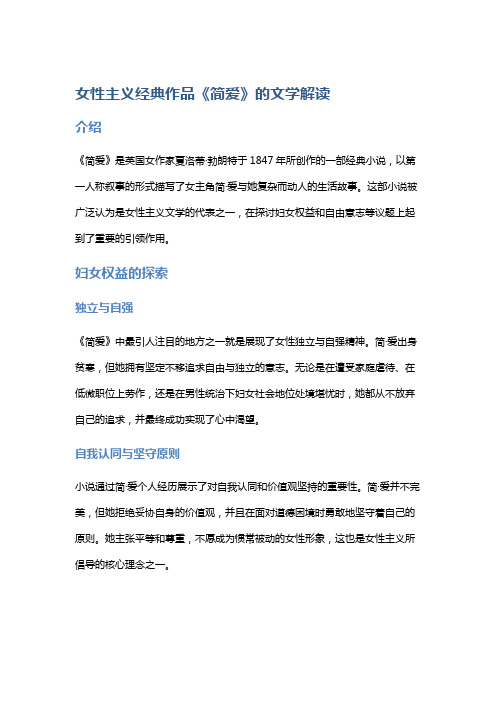
女性主义经典作品《简爱》的文学解读介绍《简爱》是英国女作家夏洛蒂·勃朗特于1847年所创作的一部经典小说,以第一人称叙事的形式描写了女主角简·爱与她复杂而动人的生活故事。
这部小说被广泛认为是女性主义文学的代表之一,在探讨妇女权益和自由意志等议题上起到了重要的引领作用。
妇女权益的探索独立与自强《简爱》中最引人注目的地方之一就是展现了女性独立与自强精神。
简·爱出身贫寒,但她拥有坚定不移追求自由与独立的意志。
无论是在遭受家庭虐待、在低微职位上劳作,还是在男性统治下妇女社会地位处境堪忧时,她都从不放弃自己的追求,并最终成功实现了心中渴望。
自我认同与坚守原则小说通过简·爱个人经历展示了对自我认同和价值观坚持的重要性。
简·爱并不完美,但她拒绝妥协自身的价值观,并且在面对道德困境时勇敢地坚守着自己的原则。
她主张平等和尊重,不愿成为惯常被动的女性形象,这也是女性主义所倡导的核心理念之一。
对爱与婚姻的思考独立选择爱情《简爱》中所描绘的是一个融合了浪漫与现实主义元素的爱情故事。
简·爱意识到自己需要得到社会认同和尊重,并明白了个人幸福不能只依赖他人。
因此,她拥有了及时放弃不健康关系、独立追求真正幸福的能力。
打破传统婚姻观念夏洛蒂·勃朗特通过《简爱》探讨了当时男权社会中婚姻制度对女性带来的束缚和依附。
小说中展示了结合谋杀、社会地位等方面问题来挑战传统婚姻观念,并通过简·爱表达了女性应该追求真正充实而平等的婚姻。
结论《简爱》作为女性主义经典作品,反映了夏洛蒂·勃朗特对女性地位和权益的关注。
通过描绘简·爱这个富有坚定意志和自我认同的女性形象,小说发出了对人权与妇女自由的呼吁。
它在当时不仅是一本重要的文学作品,也被视为早期女性主义思想的代表之一,激励着无数读者追求平等、独立和自主选择的人生。
从女性主义的角度分析《简爱》
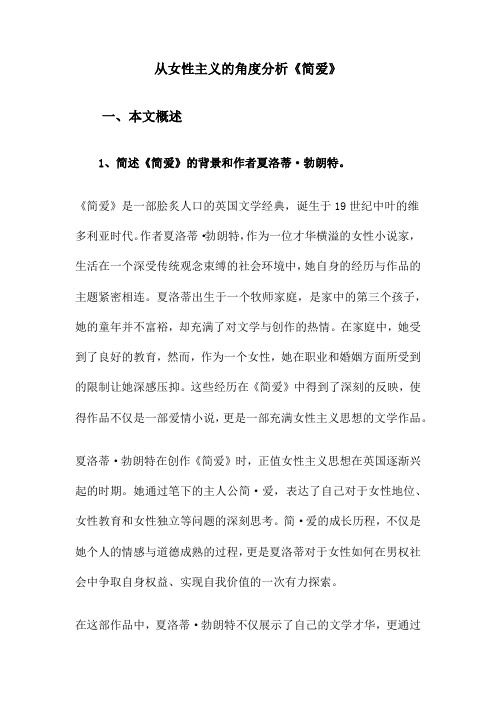
从女性主义的角度分析《简爱》一、本文概述1、简述《简爱》的背景和作者夏洛蒂·勃朗特。
《简爱》是一部脍炙人口的英国文学经典,诞生于19世纪中叶的维多利亚时代。
作者夏洛蒂·勃朗特,作为一位才华横溢的女性小说家,生活在一个深受传统观念束缚的社会环境中,她自身的经历与作品的主题紧密相连。
夏洛蒂出生于一个牧师家庭,是家中的第三个孩子,她的童年并不富裕,却充满了对文学与创作的热情。
在家庭中,她受到了良好的教育,然而,作为一个女性,她在职业和婚姻方面所受到的限制让她深感压抑。
这些经历在《简爱》中得到了深刻的反映,使得作品不仅是一部爱情小说,更是一部充满女性主义思想的文学作品。
夏洛蒂·勃朗特在创作《简爱》时,正值女性主义思想在英国逐渐兴起的时期。
她通过笔下的主人公简·爱,表达了自己对于女性地位、女性教育和女性独立等问题的深刻思考。
简·爱的成长历程,不仅是她个人的情感与道德成熟的过程,更是夏洛蒂对于女性如何在男权社会中争取自身权益、实现自我价值的一次有力探索。
在这部作品中,夏洛蒂·勃朗特不仅展示了自己的文学才华,更通过女性主义的视角,为后世留下了一部具有深远影响的文学经典。
2、阐述女性主义的基本理念和在文学作品中的体现。
女性主义,亦称女权主义,是一种关注女性权利和平等的政治、社会和文化运动。
它的核心理念包括女性的权利和平等机会,反对性别歧视,提倡性别平等,以及重视和尊重女性的经验和观点。
女性主义强调,女性不应仅仅被视为男性社会的附属品或装饰品,而是应该作为独立的个体,拥有与男性同等的权利和机会。
在文学作品中,女性主义的理念常常通过描绘女性的生活经历、挑战和抗争来体现。
这些作品常常揭示出女性在社会、文化和家庭中所面临的压迫和歧视,以及她们如何努力争取自己的权益和尊严。
在《简爱》这部作品中,女性主义的体现尤为明显。
夏洛蒂·勃朗特通过主人公简·爱的成长历程,深刻地揭示了女性在社会中的地位和处境。
从女性主义视角看简爱形象
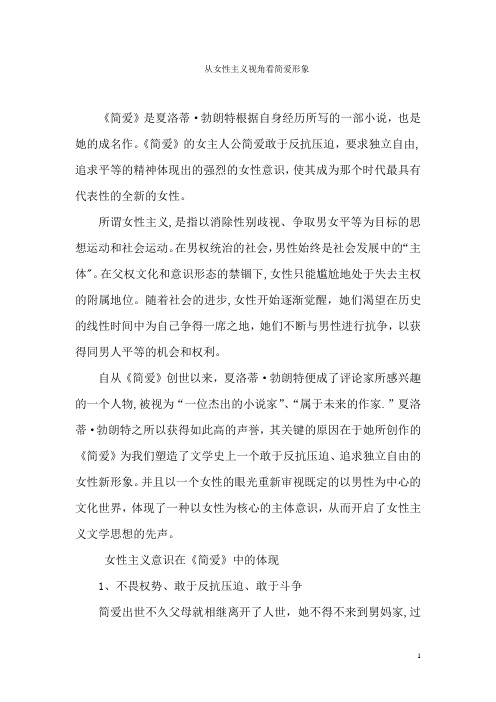
从女性主义视角看简爱形象《简爱》是夏洛蒂·勃朗特根据自身经历所写的一部小说,也是她的成名作。
《简爱》的女主人公简爱敢于反抗压迫,要求独立自由,追求平等的精神体现出的强烈的女性意识,使其成为那个时代最具有代表性的全新的女性。
所谓女性主义,是指以消除性别歧视、争取男女平等为目标的思想运动和社会运动。
在男权统治的社会,男性始终是社会发展中的“主体"。
在父权文化和意识形态的禁锢下,女性只能尴尬地处于失去主权的附属地位。
随着社会的进步,女性开始逐渐觉醒,她们渴望在历史的线性时间中为自己争得一席之地,她们不断与男性进行抗争,以获得同男人平等的机会和权利。
自从《简爱》创世以来,夏洛蒂·勃朗特便成了评论家所感兴趣的一个人物,被视为“一位杰出的小说家”、“属于未来的作家.”夏洛蒂·勃朗特之所以获得如此高的声誉,其关键的原因在于她所创作的《简爱》为我们塑造了文学史上一个敢于反抗压迫、追求独立自由的女性新形象。
并且以一个女性的眼光重新审视既定的以男性为中心的文化世界,体现了一种以女性为核心的主体意识,从而开启了女性主义文学思想的先声。
女性主义意识在《简爱》中的体现1、不畏权势、敢于反抗压迫、敢于斗争简爱出世不久父母就相继离开了人世,她不得不来到舅妈家,过着寄人篱下的生活。
她从小就承受着与同龄人不一样的待遇:舅妈的嫌弃,表姐的蔑视,表哥的侮辱和毒打……这一切都令简爱感到痛苦不堪,从而产生强烈的反抗意识。
终于在她被表哥打得头破血流之际,她发疯似地和他对打,使尽全力狠狠地揍他一拳,并发泄地叫道:“你这个男孩真是又恶毒又残酷!你像个杀人犯!你像个虐待奴隶的人!你像罗马的皇帝!”她甚至敢于对她残忍的舅母说:“世界上我最恨的人就是你!"她在即将被送往劳渥德寄宿学校时,向舅妈宣称:“我很庆幸你不是我亲戚,今生今世我再也不会叫你舅妈了。
"对寄养家庭的反抗导致了简爱被送进劳渥德孤儿院.如果说简爱在舅妈家刚刚萌发了反抗性格的话,那么到了孤儿院,在劳渥德学校,她的反抗性格则得到进一步发展。
女性主义视角下的《简爱》解读
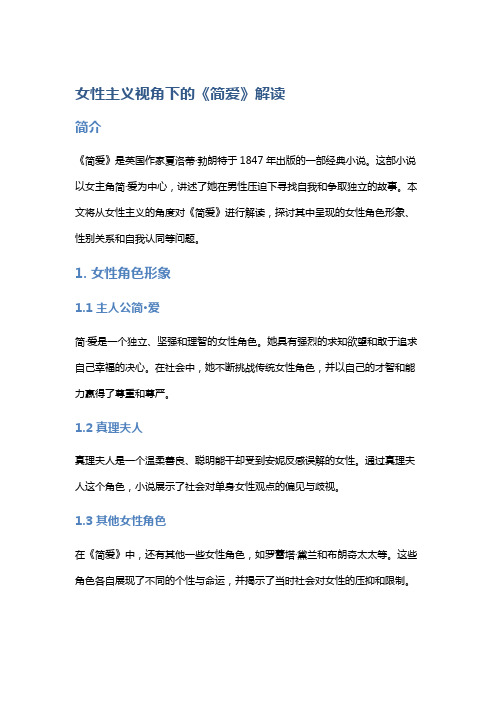
女性主义视角下的《简爱》解读简介《简爱》是英国作家夏洛蒂·勃朗特于1847年出版的一部经典小说。
这部小说以女主角简·爱为中心,讲述了她在男性压迫下寻找自我和争取独立的故事。
本文将从女性主义的角度对《简爱》进行解读,探讨其中呈现的女性角色形象、性别关系和自我认同等问题。
1. 女性角色形象1.1 主人公简·爱简·爱是一个独立、坚强和理智的女性角色。
她具有强烈的求知欲望和敢于追求自己幸福的决心。
在社会中,她不断挑战传统女性角色,并以自己的才智和能力赢得了尊重和尊严。
1.2 真理夫人真理夫人是一个温柔善良、聪明能干却受到安妮反感误解的女性。
通过真理夫人这个角色,小说展示了社会对单身女性观点的偏见与歧视。
1.3 其他女性角色在《简爱》中,还有其他一些女性角色,如罗蕾塔·黛兰和布朗奇太太等。
这些角色各自展现了不同的个性与命运,并揭示了当时社会对女性的压抑和限制。
2. 性别关系2.1 爱情与婚姻小说中描绘了男主角罗切斯特与简·爱之间的情感纠葛。
从开始相识到最后相守,他们之间逐渐建立起平等与互助的关系。
通过描写这段感情经历,小说呈现出一种不用依附于男人就能获得幸福的态度。
2.2 权力与控制在小说中,简·爱经历了被不公正对待和受到控制的过程。
她面临着男权主义社会对女性地位和能力的限制,但是她反抗并最终摆脱了这些束缚。
3. 自我认同3.1 对个体价值的追求《简爱》突出了个体价值、独立思考和自主选择的重要性。
作者通过主人公简·爱所经历的成长过程,表达了对女性追求自由和独立的鼓励与呼吁。
3.2 自我实现与自我认同简·爱通过不断学习、思考,并坚守自己内心的原则和信仰,最终实现了她个人价值和自我认同。
这位女性角色成为了一种象征,勇敢地追求梦想并超越了性别枷锁。
结论从女性主义视角看,《简爱》是一部强调女性权利与平等的经典小说。
通过塑造独立而强大的女性形象,揭示了当时社会中存在的性别歧视问题,并倡导女性为自己争取平等权益和个人发展空间。
从女性主义的角度分析《简.爱》

从女性主义的角度分析《简.爱》摘要:《简・爱》是19世纪英国批判现实主义文学作家夏洛蒂・勃朗特的代表作。
它成功地塑造了英国文学史中第一个对爱情、生活、社会以及宗教都采取了独立自主的积极进取态度和敢于斗争、敢于争取自由平等地位的女性形象。
本文主要从四个生活场景展示了简爱反抗性格的萌芽、产生、发展和高潮四个阶段。
关键词:夏洛蒂・勃朗特简・爱女性主义作者简介:王佩(1982―),女,陕西榆林人,西北大学外国语学院英语语言文学硕士,欧亚学院英语教师,助教,主要从事英语教学、英汉语言与文化对比研究。
任静(1983―),女,陕西铜川人,西北大学外国语学院英语语言文学硕士,陕西职业技术学院英语教师,助教,主要从事英语教学、英汉语言与文化对比研究。
夏洛蒂・勃朗特是十九世纪英国杰出的女作家,她的代表作《简・爱》自出版以来受到读者和文学评论者的广泛关注和欢迎。
从很大程度上讲,《简・爱》被认为是作者的心理历程的自传体小说。
夏洛蒂把自己的很多的人生经历和性格特点都赋予了她作品中的女主人公一简・爱。
夏洛蒂在这部小说中塑造了敢与命运抗争的女性新形象,反映了生活在父权制社会底层的妇女内心的呐喊,给当时的英国社会带来巨大的影响。
小说以简・爱生活的四个生活场景在盖兹海德府,在劳渥德学校,在桑菲尔德,在圣约翰家,展示了简爱反抗性格的萌芽、产生、发展和高潮四个阶段。
本文旨在从女性主义的角度,通过对作品中女主角简・爱成长环境的分析,揭示这部小说中所反映的维多利亚时期女性性别意识的觉醒和当时女性的社会地位,从而进一步了解作为女性作家的夏洛蒂在作品中反映出的女性作家的性别颠覆意识。
一、女性意识的萌芽――在盖兹海德府简・爱还在幼年时,父母就染病去世。
她被送到盖茨海德庄园的舅母里德太太家抚养。
里德太太是一个冷酷、自私的人。
她把简爱当作佣人对待,而对自己的三个掌上明珠却百般溺爱。
简・爱在里德太太家的地位,连使女都不如,受尽了表兄表姊妹的欺侮。
“他欺侮我,虐待我,不是一周三两次,也不是一天两回,而是经常如此……”(p.6)一天表兄又打她了,她回手反抗,却被舅母关进红房子里,她的舅舅里德先生就死在这间屋子里。
女性主义视角解读《简爱》:独立、自由与爱情
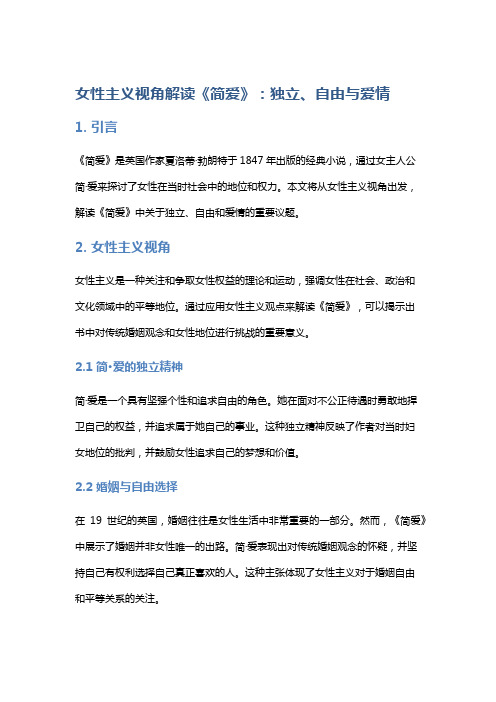
女性主义视角解读《简爱》:独立、自由与爱情1. 引言《简爱》是英国作家夏洛蒂·勃朗特于1847年出版的经典小说,通过女主人公简·爱来探讨了女性在当时社会中的地位和权力。
本文将从女性主义视角出发,解读《简爱》中关于独立、自由和爱情的重要议题。
2. 女性主义视角女性主义是一种关注和争取女性权益的理论和运动,强调女性在社会、政治和文化领域中的平等地位。
通过应用女性主义观点来解读《简爱》,可以揭示出书中对传统婚姻观念和女性地位进行挑战的重要意义。
2.1 简·爱的独立精神简·爱是一个具有坚强个性和追求自由的角色。
她在面对不公正待遇时勇敢地捍卫自己的权益,并追求属于她自己的事业。
这种独立精神反映了作者对当时妇女地位的批判,并鼓励女性追求自己的梦想和价值。
2.2 婚姻与自由选择在19世纪的英国,婚姻往往是女性生活中非常重要的一部分。
然而,《简爱》中展示了婚姻并非女性唯一的出路。
简·爱表现出对传统婚姻观念的怀疑,并坚持自己有权利选择自己真正喜欢的人。
这种主张体现了女性主义对于婚姻自由和平等关系的关注。
3. 爱情与女性权力《简爱》在探讨爱情主题时也涉及到了女性权力的问题。
通过描写简·爱与罗切斯特之间复杂而富有冲突的感情,小说展现出了女性在爱情中寻找平等地位和权力的努力。
3.1 简·爱与罗切斯特:平等伴侣关系简·爱与罗切斯特之间建立起一种相对平等和互相尊重的伴侣关系。
作者既强调了女性在家庭中发挥积极作用的重要性,又呼吁男性对女性保持尊重和平等。
这种展现方式与当时的爱情观念形成了鲜明的对比,奠定了女性主义视角解读《简爱》的基础。
3.2 爱情的限制与解放尽管小说探讨了一种较为平等和进步的伴侣关系,但它也揭示出爱情可能给女性带来的限制和束缚。
简·爱在面临道德选择时,拒绝成为罗切斯特婚姻外遇中的另一个牺牲品。
这体现了对传统爱情观念进行批判,并强调女性应当追求自己的独立和自由。
女性主义视角下的《简爱》: 自由与独立的探索

女性主义视角下的《简爱》: 自由与独立的探索概述在19世纪英国文学中,夏洛特·勃朗特的小说《简·爱》被誉为是女性主义经典之作。
本文旨在从女性主义的视角出发,深入探讨小说中主人公简·爱如何通过自由与独立的探索来实现自我解放与价值追求。
简爱个人背景简·爱是一个智慧、坚强和勇敢的女孩,她在一个贫穷而苦难的家庭中长大。
她从小受到歧视和压迫,但仍然保持着对生活和自己积极乐观的态度。
这种坚韧不拔的品质使她成为19世纪女性形象中战胜困境的典范。
社会桎梏与束缚在那个时代,社会对女性有着严格而制约性的规范,女性要俯首听命于男性,并将家务劳动和照顾孩子作为唯一使命。
然而,在这样限制自由并剥夺个人权益的环境下,简·爱并没有放弃她对自由和独立的追求。
自由与独立的渴望简·爱在故事中展示了对自由的强烈渴望。
她希望能够摆脱社会桎梏,争取平等的权益和选择权。
她渴望不仅仅是一个职业上的成功,而是寻找属于自己的灵魂伴侣和幸福生活。
她通过接受教育、努力工作并坚持自我价值来实现自由与独立。
自我解放的过程《简爱》描绘了简·爱面对各种困境和阻碍时如何坚持自己内心渴望,并最终实现个人解放的过程。
她经历了艰难的童年、苦难的斯考顿世、变态宗教家族以及与罗切斯特先生之间复杂而纠结的关系。
在这些挑战中,她始终保持着心中燃烧着自由之火,并最终找到了属于自己的幸福。
女性主义主题分析小说中的女性角色呈现了女性主义的核心价值观:选择权、平等和自我实现。
简·爱通过她的经历,挑战了当时社会对女性的既定规范,为其他女性提供了勇敢面对困境并争取自由的榜样。
影响与启示《简爱》从女性主义的视角出发,探讨了女性在追求自由和独立过程中所面临的挑战和难题。
这部作品不仅激励着读者去反思社会对女性的限制,也为后来者提供了信心和决心去追求个人价值与生活幸福。
结论以女性主义视角解读《简·爱》,使我们更加深入地思考女性自由与独立的重要性。
从女权主义的视角解读《简爱》
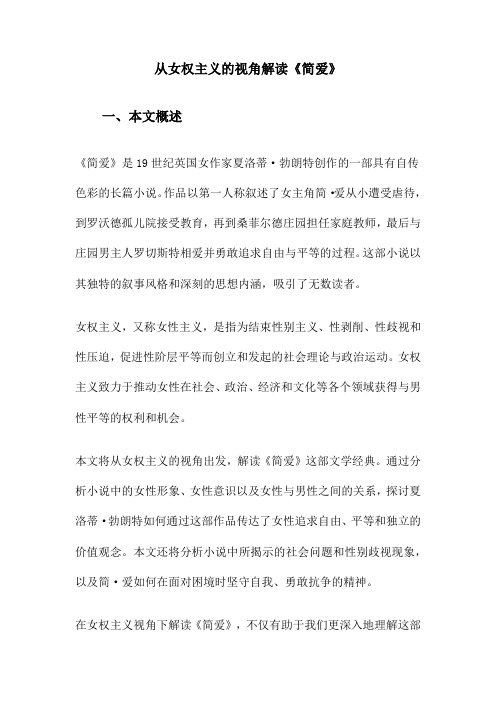
从女权主义的视角解读《简爱》一、本文概述《简爱》是19世纪英国女作家夏洛蒂·勃朗特创作的一部具有自传色彩的长篇小说。
作品以第一人称叙述了女主角简·爱从小遭受虐待,到罗沃德孤儿院接受教育,再到桑菲尔德庄园担任家庭教师,最后与庄园男主人罗切斯特相爱并勇敢追求自由与平等的过程。
这部小说以其独特的叙事风格和深刻的思想内涵,吸引了无数读者。
女权主义,又称女性主义,是指为结束性别主义、性剥削、性歧视和性压迫,促进性阶层平等而创立和发起的社会理论与政治运动。
女权主义致力于推动女性在社会、政治、经济和文化等各个领域获得与男性平等的权利和机会。
本文将从女权主义的视角出发,解读《简爱》这部文学经典。
通过分析小说中的女性形象、女性意识以及女性与男性之间的关系,探讨夏洛蒂·勃朗特如何通过这部作品传达了女性追求自由、平等和独立的价值观念。
本文还将分析小说中所揭示的社会问题和性别歧视现象,以及简·爱如何在面对困境时坚守自我、勇敢抗争的精神。
在女权主义视角下解读《简爱》,不仅有助于我们更深入地理解这部文学作品的内涵和价值,还能为我们提供新的视角和思考方式,以更好地认识和处理现实生活中存在的性别问题。
二、《简爱》中的女性形象《简爱》中的女性形象,以主角简·爱为核心,呈现出一种鲜明的女权主义色彩。
简·爱不仅是一个勇敢、独立、坚韧的女性,更是一个对自我价值和尊严有着坚定追求的女性。
简·爱的成长经历就充满了女权主义的抗争。
她自幼父母双亡,被寄养在舅母家,遭受虐待。
然而,她并没有屈服于这种命运,而是选择了反抗。
在洛伍德义塾,她面对恶劣的环境,依然顽强地生存下来。
这种坚韧不屈的精神,正是女权主义所倡导的——女性应该有自己的意志和力量,不应该被动地接受命运的安排。
简·爱对待感情的态度也体现了女权主义的观念。
在面对罗切斯特这个强大而神秘的男性时,她没有卑躬屈膝,也没有失去自我。
简爱女性主义分析

摘要夏洛蒂·勃朗特是生活在维多利亚前期的一位有着强烈女性意识的伟大作家。
独特的个性、悲惨的生活遭遇以及充满矛盾的时代共同促使了其女性意识的形成,它借助其语言文学作品《简·爱》中的女主人公表现出来。
女主人公简·爱出身贫寒,地位卑下却不甘被歧视,不甘自己被社会同化。
她敢爱敢恨,敢于反抗社会的不公,追求平等、自尊、自强。
她有忍耐的度量,但是又敢于表达自己的不满,她有辨别是非的能力,敢于指正错误,她有爱有恨,知道什么是真爱。
她生活中的种种不幸并没有将她打倒,反而激起了她要反抗要自尊要自强的决心。
本文通过具体分析简在盖茨黑德、洛伍德、桑菲尔德以及离开桑菲尔德之后四个阶段中的行为来充分论证简·爱中的女性主义的体现及发展。
关键词:简·爱;夏洛蒂·勃朗特;女性主义;自尊AbstractCharlotte Bronte is a great writer living in the earlier Victorian Era with a strong feminine consciousness. It is her unique individuality, miserable experience and fully contradictory era that make her feminine consciousness formed. It is expressed by the heroine of the literary work Jane Eyre.The heroine Jane Eyre was born to be poor and humble, but she was unwilling to be discriminated and be assimilated by society. She has the courage to love and hate, dares to resist unfair in society, to pursue equal position, self-respect and independence. She has great endurance, but dares to express her dissatisfaction; she has the ability to distinguish between right and wrong, and dares to correct mistakes; she has love and hatred, and knows what true love is. A variety of unhappiness in her life does not defeat her, but arouse her decision to be self-respected and to be self-contained. This thesis aims to evidently prove the feminism contained in Jane Eyre by specifically analyzing Jane’s behaviors in Gateshead, Lowood, Thornfield and off Thornfield the four periods.Key words: Jane Eyre; Charlotte Bronte; feminism; self-respectContents摘要 (I)Abstract (II)1Introduction (1)2The development of feminism (1)3The reasons why Jane has feminine ideas (2)3.1Charlotte’s own life experience (2)3.2The background of that era (2)4The influence of feminism on Jane Eyre (3)4.1In Gateshead (3)4.1.1Jane's clear love, hatred and her own protection (3)4.1.2Jane’s accusation against the lies of Mrs. Reed (4)4.2In lowood institution (4)4.2.1Feminine ideas in the spirit of resistance (4)4.2.2Feminine ideas in the criticism of that charity school (5)4.3In Thornfield (5)4.3.1Jane’s dignity against Mr. Rochester’s pride (5)4.3.2Jane’s determination to leave Thornfield (6)4.4Off Thornfield (6)5Conclusion (7)References (8)1IntroductionCharlotte Bronte is a famous Britain writer in 19th century. Her life stories are an epitome of Jane Eyre’s plot. Charlotte was born in minister family who died mother in her five years old. The poor living conditions made her two sisters died from lung disease. So she and her sister Emily had been taken back to her hometown by her father. Then she studied in the women’s church school. And her Jane Eyre is the outstanding British novel in the 19th century. It is the independence, self-esteem and the thought of feminism that attract the attention of readers all around the world. In the novel Jane Eyre is a new type of women. She changed the women image of gentle, sweet and meek in the traditional British. She was born poor and unremarkable but opposed humiliation behaviour firmly and always defended her independent personality. And finally it ended with the perfect love between Jane and Mr. Rochester. This book expresses the author’s th oughts for love、ideal and relationships among people which taking the first person narration of heroine to lead the development of the story. It made readers see real life hypocrisy, the differences between rich and poor and the discrimination for the poor. A woman was born poor and humble but unwilling to be discriminated and unwilling to be assimilated by the society. She constantly rival malice forces, constantly pursue ego independence and freedom. Her rational thinking process is not as simple as a cognitive process of things but a kind of race process between good and evil. She has great endurance but dares to express her discontent; she has the ability to distinguish right or wrong but dares to correct mistakes; she has love and hatred but knows what true love is. Through this character she tried to divulge such information that I am not your favourite woman but I am not inferior. I am in short stature but I am independent and have self-esteem. This obviously is a major progress of feminine literature in the British literature.2The development of feminismFeminist theories have emerged as early as 1792 in such publications as “the changing woman”, and so on. In 1851, Sojourner Truth addressed women’s righ ts issues through herpublication, “am not I a woman?” and addressed the issues surrounding limited rights to women based on the flawed perceptions that men held of women. In 1872, Anthony critiqued the constitution for its male gendered language and questioned why women should have to abide by laws that do not specify women. The resurgence of feminist activism in the late 1960s was accompanied by an emerging literature of what might be considered female associated issues, such as concerns for the earth and spirituality and environmental activism. Julia Kristina, Brachia Ettinger and Luce Irizarry developed specific notions concerning unconscious sexual difference, the feminine and motherhood, with wide implications for film and literature analysis.3The reasons why Jane has feminine ideas3.1Charlotte’s own life experienceJane Eyre’s life experience is just like Charlotte’s. Charlotte lost her mother when she was five years old. Her two sisters died from lung disease when they were in school. She had to take care of her little sister and brother. Their brother once they loved most and made them proud most was astray; her father had suffered cataract and was nearly blind, that led her to be depressed; sisters were young and sick needed her to take care of; her first novel professors was also rejected frequently; the cold and dark conditions also tormented her body. Living in such a life, she persisted in writing on Jane Eyre.There is no ordinary people can afford. All of these were deeply condensed in her works. It is the burden of her family that let charlotte be independent. Her life experience and inner experience prompted insight and motivate her to choose and model a generation of real new woman with women’s consciousness. As a woman, she wishes to be treated equally in society. So her exploration about feminism was expressed through her work Jane Eyre.3.2The background of that eraThe book Jane Eyre was written in Victorian era. At the beginning of the 19th century, little opportunity existed for women, and thus many of them felt uncomfortable whenattempting to enter many parts of society. The absence of advanced educational opportunities for women and their alienation from almost all fields of work gave them little option in life; either becomes a house wife or a governess. Although today a tutor may be considered a fairly high class and intellectual job, in the Victorian era governess was little more than a servant who was paid to share her scarce amount of knowledge in limited fields to a child. With little respect, security, or class one may certainly feel that an intelligent, passionate and opinionated young woman such as Jane Eyre should deserve and be capable of so much more? The insecurity of this position, being tossed around with complete disregard for her feelings or preferences, is only one of many gruelling characteristics of this occupation. However for Jane to even emerge into society, becoming a governess seemed the only reasonable path for her. The women of the Victorian Era can be regarded as first group to do battle for the equality of the sexes. They lead all women to follow after them, and though their progression may not have been as vivid as the women of the 70’s, they did have an effect. Feminism was not outright spoken of that time, rather passed through literature, such as this very novel.4The influence of feminism on Jane Eyre4.1In Gateshead4.1.1Jane's clear love, hatred and her own protectionThe heroine lives in her Aunt Mrs. Reed’s home for her parents died. Unfortunately her uncle also died. Her uncle had charged her aunt to treat Jane as their own daughter in his deathbed. However this does not change Jane’s destiny to be abused by Mrs.Reed and cousin. Mrs. Reed’s cold ness makes Jane to produced hatred. During the days of living in her a unt’s home, it is the sisters’apathy, Mrs. Reed’s eccentric even the servants’discrimination that let Jane produce strong rebel psychology. Facing John Reed’s despotism, she was unbearable and fearless, “wicked and cruel boy! You are like a murderer—you are like a slave-driver—you are like the roman emperors!”(Bronte 2003, 5) She even fights with John Reed like a mad. She does not understand why she always bebullied, be beaten, be scolded, be tortured and be discriminated. But cruel living environment never made Jane yield and she cried out gravamen for herself.4.1.2Jane’s accusation against the lies of Mrs. ReedMrs. Reed thought she can scare her niece with her position, but on the contrary Jane gives back the tit-for-tat.“I am not deceitful: if I were, I should say I loved you; but I declare I do not love you:I dislike you the worst of anybody in the world except John Reed: and. This bookabout Liar, you may give to your girl, Georgiana, for it is she who tells lies, and notI.”(Bronte 2003, 29) “People think you a good woman, but you are bad, hardhearted.You are deceitful!”(Bronte 2003, 30)Mrs. Reed would also incredibly be afraid, even in years later she wrote back to Jane’s uncle who wants Jane to inherit his property that Jane had already been dead.“Such a burden to be left on my hands—and so much annoyance as she caused me daily and hourly, with her incomprehensible disposition and her sudden fits of temper, and her continual, unnatural witching of one’s movement! I declare she talked to me once like something mad, or like a friend—no child ever spoke or looked as she did; I was glad to get her away from the house. What did they do with her at Lowood? The fever broke out there, and many of the pupils died. She, however, did not die: but I said she died —I wish she had died!”(Bronte 2003, 219–220)This let us preliminary see Jane’s self-improvement and resistance characteristic.4.2In lowood institution4.2.1Feminine ideas in the spirit of resistanceFacing the unprovoked beat and scold, Jane and Helen’s ideas are not the same. Jane wears from a thus unconquerable spirit of resistance. So she has the courage to resist. She said to Helen who was punished: “And if I were in your place I should dislike her; I should resisther; if she struck me with that rod, I should get it from her hand; I should break it under her nose.” (Bronte 2003, 48)4.2.2Feminine ideas in the criticism of that charity schoolIn this school children are starving, also suffer from various humiliate, meals are bad and the living environment is unsanitary. “Semi-starvation and neglected colds had predisposed most of the pupils to receive infection: forty-five out of the eighty girls lay ill at one time.”(Bronte 2003, 69) In fact, this is not simply a charity institution; the author strongly criticized the education system which is so cruel. With this critical spirit, she created Mr. Brocklehurst who is a hypocritical image. Also filled with the spirit of indignation, she described a victim Helen. But the reason why the author write these is not to show people what charity school is, but to highlight Jane’s r esistance spirit which has already formed in Mrs. Reed’s home by telling such a bad environment. Jane is not afraid of hard life, but hates this school especially Mr. Brocklehurst. If the object of Jane resist against is only the Reeds, the objects of little Jane resist against are broaden when she is in lowood. Her resistance spirit has been formed.4.3In Thornfield4.3.1Jane’s dignity against Mr. Rochester’s prideLove is eternal theme of life. It is said that woman is an emotional animal. They can expose their real inner world, especially in social reality, the value of female existence often manifested by love and marriage. Jane is bold to fall in love with her master Mr. Rochester. She is graceful in front of high and bullied impetuous Mr. Rochester. Her self-esteem and tenacity gradually attracted Mr. Rochester. When she misunderstanding Mr. Rochester would marry Miss Ingram, she was bold to cry out her repressed emotions like volcanic eruptions.“Do you think I can stay to become nothing to you? Do you thin k I am an automaton?— A machine without feelings? And can bear to have my morsel of bread snatchedfrom my lips, and my drop of living water dashed from my cup? Do you think, because I am poor, obscure, plain, and little, I am soulless and heartless? You think wrong! — I have as much soul al you-and full as much heart! And if God had gifted me with some beauty and much wealth, I should have made it as hard for you to leave me, as it is now for me to leave you. I am not talking to you now through the medium of custom, conventionalities, nor even of mortal flesh: it is my spirit that addresses your spirit; just al if both had passed through the grave, and we stood at God’s feet, equal-as we are!” (Bronte 2003, 240–241)This firmly shows women’s longing for fr eedom and equality.4.3.2Jane’s determination to leave ThornfieldHer wedding was destroyed and her happiness was lost. After thinking twice, she decided to leave Thornfield even though she loves Mr. Rochester deeply. She did not know where to go. The only wish is to leave Thornfield for she had been cheated and insulted. If Jane were still there she would be Mr. Rochester’s mistress which is a sad status and identity. Does she live in dishonour or maintain personal dignity? Jane Eyre who does not accept Mr. Roc hester’s any gift chose the latter without hesitation and stepped out of the Thornfield’s gate bravely. The arrangement of this plot is the top mark of Jane’s resistance spirit.4.4Off ThornfieldAfter leaving Thornfield, Jane came to a new place beginning her new life. During her relationship with St. John, her character flashed the extraordinary splendour naturally. St. John proposed to Jane Eyre several times. But he does not love her. The reason why he proposed was just to finish the task of god, to make Christianity spread to broader place. His proposal even liked a command.“He has again and again explained that it is not himself, but his office, he wishes to mate. He has told me I am formed for labour-not for love: which is true, no doubt. But,in my opinion, if I am not formed for love, it follows that I am not formed for marriage.Would it not be strange to be chained for life to a man who regarded one but as a useful tool? ” (Bronte 2003, 400)Here St. John treats Jane as a tool, as the servant of god. Jane Eyre refused St. John determinedly; she thought that a marriage without love is not equal.5ConclusionJane Eyre portrayed a brave, intelligent, independent and positive new female image. Jane Eyre lived a hard life, filled with hatred and anger. However, her ability to overcome all of this shows her strength; a power that superficial women would not posses. She was a weaker but never be succumbing to her fate which fully shows her feminine consciousness. This thesis analyzes the book Jane Eyre specifically. It analyzes the development of Jane Eyre’s feminism. When Jane was in Gateshead, she resisted to her aunt and cousin; when she was in school, she resisted the headmaster; when she was in Thornfield, she struggled for her love. All her experience shows that she was eager to be respected. This is the spirit of feminism. As women we do not have a desire to control men, but want to be equal with men and to be respected by men.ReferencesBronte, C. 2003. Jane Eyre. Shanghai. Shanghai World Publishing Corporation. November.Li Rong. 2009. Jane Eyre’s Feminine Ideas. Science & Technology Information.September.Huang Quan. JianpingZeng. 2009. Jindai yingguo wenxue zhong nüxingzhuyisixiangde shanbian. [The Change of Feminine Ideas in Modern British Literature. Translations.February.Gong yi. 2010. Qianxin jianaide fankangjingshen jiqi shidaiyiyi. [Jane Eyre’s Resisting Spirit and its Magnificent]. Journal of JiuJiang university. (Social Sciences).February.Wang Xiaoxia. 2010. Cong nüquanzhuyi shijiao jiedu jianai. [Analyzing Jane Eyre from the Respect of Feminism]. Overseas English. May.Zhu Jiake. 2009. Yingyu wenxuezuopin jianaizhongde nvxingyishide tixian. [The Feminism in Jane Eyre]. Shidai wenxue.February.Cott, Nancy F. New Haven. 1987. The Grounding of Modern Feminism. Yale University Press.8。
- 1、下载文档前请自行甄别文档内容的完整性,平台不提供额外的编辑、内容补充、找答案等附加服务。
- 2、"仅部分预览"的文档,不可在线预览部分如存在完整性等问题,可反馈申请退款(可完整预览的文档不适用该条件!)。
- 3、如文档侵犯您的权益,请联系客服反馈,我们会尽快为您处理(人工客服工作时间:9:00-18:30)。
IntroductionJane Eyre is such a great novel that it holds an important position in the history of British literature. It is also the masterpiece of Charlotte Bronte, who is a famous talented realistic woman novelist in English literature history. It has been translated into various languages and adapted for movie, dazzling generations of readers all through the world.This thesis mainly discusses the female doctrine of Jane in the social background of realism. Jane is neither a very beautiful woman, nor rich, but her genuine, selfless love for Rochester, and her good personality strike us deeply. It was written successfully to portray its heroine --Jane Eyre , a independent woman, who takes an positive and progressive attitude toward love, life , society and religions, and who dares to fight for the liberty and equality. Jane's sufferings are the deep reflections of the lives of lower-class people in Britain . The author shaped her heroine as a lower-class, awaken, and new feminine , who resists oppression and social prejudice strongly, fight for independent personality and dignity firmly ,and pursue happy life consistently. It is rather rare in the novels of that period. The period when Jane (the heroine in the novel Jane Eyre) lived roughly corresponds with the time of queen Victoria’s ruling. Victoria who ruled over the British Empire for over 60 years was a well known queen in English history. She mounted the throne in 1837 when British literature reached a prosperous period. In the 1940s, British literature reached its peak. The realists were one of the main groups at that time, and the author of Jane Eyre belonged to this group.A brief information about Charlotte BrontëCharlotte Bronte (1816-1855) was born in the family of a poor country clergyman at Haworth, Yorkshire, in northern England. In this period of tense class struggle appeared a new literary trend-critical realism. English critical realism of the 19 th century flourished in the forties and in the early fifties. The critical realists described with much vividness and great artistic skill the chief traits of the English society and criticized the capitalist system from a democratic viewpoint.Shehad two elder sisters, two younger sisters and one younger brother. Her mother died when she was five years old, leaving six children. Fortunately, her father was an intellect, so he often taught his children to read books and magazines and told stories to them. It influenced Charlotte in developing her interest in literature. When she was very young, she was sent to a boarding school with her three sisters. In 1825, her two elder sisters died of infectious disease in that school. Then, her younger sister Emily and she were forced to go back home and compile a journal named “Youth”, which laid a solid foundation for their later creation of literature. When she was 15, she went to another school to study. And in order to support her family, she became a teacher in this school after her graduation. After she left this school, she went to a rich family to be a tutor for twice, during which she declined to men who wanted to marry her.In 1847, under the name of Currer Bell, she published her first novel Jane Eyre which was a great shock at that time and made her successful. Her two younger sisters also published their novels and succeeded at that time. The great success of the Bronte sisters brought great happiness to their family. But in the following years, Charlotte suffered from great sorrow: her younger brother and two younger sisters died one by one in two years. But she persisted in writing and published another three fictions. She got married with a priest when she was 38 years old. After she enjoyed happiness for six months, she died in the next year.A Brief Contents about Jane EyreThis novel begins with little Jane as a despised orphan in the house of her uncle’s widow. Being rebellious, she is packed off to a charitable boarding school, which administers harsh discipline with especial vigor. Jane sets herself to learn, qualifies herself as a teacher, advertises for a post, and is employed as governess of the illegitimate French daughter of Rochester in his country mansion, Thornfield. A love relationship develops between Jane and Rochester. Jane’s resolute free spirit, her soul of fire, brings from the dominant Rochester a proposal of marriage. But at thevery moment, the wedding ceremony was interrupted, for Rochester is discovered to have a mad wife who is hidden in that house. Jane doesn’t want to be Rochester’s mistress and subsequently leaves Thornfield, wandering far away. She is rescued by the Rivers family and urged to marry John Rivers in order to undertake missionary work at his side. Almost she consents, but as she ponders, Rochester’s voice crying her name resounds in her ears. Then Jane gains a large amount of inheritance from her uncle whom she has never known before. She returns to Thornfield, but the mansion has been destroyed by a fire started by the mad wife. In a scheduled country house nearby, she finds Rochester, blind and alone; they marry and find happiness together.In that society, it is impossible for Jane and Rochester to be really equal in social class. They are just equal in spirit.Causes of the thought of female doctrine in Jane Eyre.1.Social and Cultural Backdrops of Jane Eyre..The period when Jane (the heroine in the novel Jane Eyre) lived roughly corresponds with the time of queen Victoria’s ruling. Victoria who ruled over the British Empire for over 60 years was a well known queen in English history. She mounted the throne in 1837 when British literature reached a prosperous period. In the 1940s, British literature reached its peak. The realists were one of the main groups at that time, and the author of Jane Eyre belonged to this group.In this period of tense class struggle appeared a new literary trend-critical realism. English critical realism of the 19 th century flourished in the forties and in the early fifties. The critical realists described with much vividness and great artistic skill the chief traits of the English society and criticized the capitalist system from a democratic viewpoint.The method of critical realism was further adopted by such writers as Charlotte and Emily Bronte, and Elizabeth Gaskell. In writing Jane Eyre, Charlotte Bronte chiefly resorts to the realistic approach, but her realism is heightened by her sparkle of romantic imagination. The novel is marked throughout by intensity,intensity of vision is the descriptive passages, intensity of feeling in the emotional scenes. The passionate involvement of the heroine Jane Eyre in every situation endows the novel, like Emily’s Wuthering Heights, with the quality of poetry, even in the medium of prose. Brontë uses the novel to express her critique of Victorian class differences. Jane is consistently a poor individual within a wealthy environment, particularly with the Reeds and at Thornfield. Her poverty creates numerous obstacles for her and her pursuit of happiness, including personal insecurity and the denial of opportunities2 .Charlotte Brontë’s thought of female doctrine in her Personal Life.Charlotte Bronte was born in a Priest’s family in York shire. She had two elder sisters, two younger sisters and one younger brother. Her mother died when she was five years old, leaving six children. Fortunately, her father was an intellect, so he often taught his children to read books and magazines and told stories to them. It influenced Charlotte in developing her interest in literature. Her sufferings are likely to her novel’s heroine, Jane Eyre, who is neither a very beautiful woman, nor rich, but her genuine, selfless love for Rochester, and her good personality strike us deeply. Charlotte, the only surviving child of the family, outlived her sisters and brother by some years, with restless energy, she wrote two other novels, “Shirley”(1849), her second novel, dealing with the life of workers at the time of the Luddites’ movement. The last novel by Charlotte Bronte, “Villette”, came out in 1853. In Villette, the author again draws from her own life experience and creates a woman character from a poor family who fights her way in the world with her intelligence, and strong will. The heroine is shown as having no money, beauty, or friends, and in order to support herself she teaches at a girls’ school at Brussels, Belgium. In 1854 she married her father’s curate A.B. Nicholas, but died a few months laterAn analysis of Images of characters in Jane Eyre.1.Image of Jane EyreThe development of Jane Eyre’s character is related to her lif e environment. From the beginning, Jane possesses a sense of her self-respect and dignity, a commitment to justice and principle, a trust in God, and a passionate disposition. Her integrity is continually tested over the course of the novel, and Jane must learn to balance the frequently conflicting aspects of herself so as to find contentment. Jane loses both of her parents shortly after birth. She lives at the household of her aunt, Mrs. Reed, an unfeeling woman, who is rude and unjust to the poor orphan. Her children also find pleasure in teasing and mocking Jane. Living under this circumstance, Jane feels exiled and ostracized at the beginning of the novel, and the cruel treatment she receives from her aunt Reed and her cousins only exacerbates her feeling of alienation. Afraid that she will never find a true sense of home or community, Jane feels the need to belong somewhere. This desire tempers her equally intense need for autonomy and freedom.Jane also struggles with the question of what type of freedom she wants. While Rochester initially offers Jane a chance to liberate her passions, Jane comes to realize that such freedom could also mean enslavement. By living as Rochester’s mistress, she would be sacrificing her dignity and integrity for the sake of her feelings. St John Rivers offers Jane another kind of freedom: the freedom to act unreservedly on her principles. He opens to Jane the possibility of exercising her talents fully by working and living with him in India. Jane eventually realizes that this freedom would also constitute a form of imprisonment, because she would be forced to keep her true feelings and her true passions always in check.Charlotte Bronte may have created the character of Jane Eyre as a means of coming to terms with elements of her own life. Much evidence suggests that Bronte, too, struggled to find a balance between love and freedom, and to find others who understood her. At many points in Jane Eyre, Jane voices the author’s radical opinion at that time.2.Image of RochesterThe expressions of female doctrine in Jane Eyre.1.Jane’s pursuit of equality in family and personal lifeThe main quest in Jane Eyre is Jane's search for family, for a sense of belonging and love. However, this search is constantly tempered by Jane’s need fo r independence. She begins the novel as an unloved orphan who is almost obsessed with finding love as a way to establish her own identity and achieve happiness. Although she does not receive any parental love from Mrs. Reed, Jane finds surrogate maternal figures throughout the rest of the novel. Bessie, Miss Temple, and even Mrs. Fairfax care for Jane and give her the love and guidance that she needs, and she returns the favor by caring for Adèle and the students at her school. Still, Jane does not feel as though she has found her true family until she falls in love with Mr. Rochester at Thornfield; he becomes more of a kindred spirit to her than any of her biological relatives could be.However, she is unable to accept Mr. Rochester’s first marriage propos al because she realizes that their marriage - one based on unequal social standing - would compromise her autonomy. Jane similarly denies St. John's marriage proposal, as it would be one of duty, not of passion. Only when she gains financial and emotional autonomy, after having received her inheritance and the familial love of her cousins, can Jane accept Rochester's offer. In fact, the blinded Rochester is more dependent on her (at least until he regains his sight). Within her marriage to Rochester, Jane finally feels completely liberated, bringing her dual questsn for family and independence to a satisfying conclusion.2.Jane Eyre’s pursuit of liberty and equality in love and marriage.Love is the most beautiful characteristic of human beings’ life and love can not be measured by one’s status, power or property. In most individuals’ life, people like to seek a meaningful, romantic relationship resulting in love, commitment, companionship and happiness. In my opinion, it is most important that a man and woman have heart and feelings that find a perfect response, and also have mutual affinity. Shakespeare said :“The course of true love never runs smooth.”Jane and Rochester get true love after a lot of sufferings. Jane loves Rochester deeply always-from the beginning to the end. There should be no distinction of property, rankor age in true love. Jane falls in love with Mr. Rochester. He who has rich experience and wisdom, is softhearted, wealthy and in high rank as well as having pride and rudeness. Rochester is older than Jane by nearly 20years and could be her father. Jane loves him, but not for his wealth and high rank, because he treats her equally and in a friendly manner, although she is very poor and in low position. She is such an excellent girl, good, intelligent,considerate that Rochester is attracted by her. It is Jane but not someone else who Rochester loves.The beautiful Miss Ingram's higher social standing, for instance, makes her Jane's main competitor for Mr. Rochester’s love, even though Jane is far superior in terms of intellect and character. Moreover, Jane’s refusal to marry Mr. Rochester because of their difference in social stations demonstrates her morality and belief in the importance of personal independence, especially in comparison to Miss Ingram’s gold-digging inclinations. Although Jane asserts that her poverty does not make her an inferior person, her eventual ascent out of poverty does help her overcome her personal obstacles. Not only does she generously divide her inheritance with her cousins, but her financial independence solves her difficulty with low self-esteem and allows her to fulfill her desire to be Mr. Rochester’s wife.Jane thinks that it is a glorious thing to have the hope of living with him and being his wife. Jane loves him with her whole heart. They have a meeting of the mind. But in that social background, people pay too much attention to property, rank and status. If the disparity is great, a pair of lovers will suffer disagreement from their families and their f riends. Mrs. Fairfax, one of Rochester’s servants, is very surprised and feels puzzled that her master is madly clinging to Jane. But both of them do not care about the difference of status and property or others’ opinion. They pursue true love. They can smash the bonds of tradition and can surmount all obstacles. They are very happy and want to be married. But their marriage is stopped by the fault that Rochester is a married man; his wife is still alive. Rochester tells the fact to her, and he is full of regret about it. He tells Jane what he has done and confesses all his past history. Mr. Rochester had tried to conceal that he has a mad wife, because he loves Jane. He is worried that she could not endure the fact and would leave him if he tells her the truth.Now he exposes his secret to Jane, which also proves his sincere love for Jane. Jane forgives him, but in order not to impair her dignity, she thinks she must leave him. She wants to be his real wife, not his mistress. Although Jane can not get married to Rochester, she still loves him. It is impossible for her to hate him. On the day she runs away, passing the door of Rochester, she can not keep the tears from raining down her face.When she is away from him, she still feels anxiety about Roches ter. It’s too difficult for her not to miss Rochester. wherever she goes, she remembers him every moment, and she often dream of him :“she was embraced by him, hearing his voice, meeting his eyes, touching his hand and face. She loved him, and was loved by him, spent all her life with him .”That is Jane’s well-remembered love for Rochester! After leaving Rochester’s home, Thornfield Hall, Jane walks and travels without any aim. She lives in hunger and cold. As she roams about whitcross, she is nearly dead because she suffers terrible hardships. St. John helps her and saves her life. St John wants to marry Jane and takes her to India with him. Although he is a little merciful and handsome, he is also very harsh and arbitrary. He considers little of Jane’s be nefit. He does not respect her or give her selfless love. Jane says if she joins St John, she will abandon half herself and if she goes to India, she will go to premature death. Jane insists that true love should be based on equality, mutual understanding and respect. She knows that to marry such a stonehearted person is to become a tool of him to serve God, so she refuses John’s proposal. She hears the voice of Rochester in her mind, then she comes back to look for Rochester. She learns that Thornfield hall has been burnt down, and that Rochester, attempting vainly to save his mad wife from the fire, loses one of his hands, is blind in both eyes, and becomes a crippled man. Now Mr. Rochester is not as rich as he used to, and he is disabled. But Jane loves him more than ever. Jane decides to stay with him and look after him for all of her life. This pair of lovers comes together in the end. But in that society such a marriage is considered uncommon and untraditional.People may think it’s strange that Jane makes her strong will to be Rochester’s bride. Nobody would like to marry him because he has lost most of hiswealth and is blind. As to Jane, she can marry a man who is much better than Mr .Rochester. Actually, not only in those days but also today, in a pair of lovers or a couple if one of them becomes disabled, maybe the other will leave him or her. But Jane is different,she considers that love is a kind of life; true love is the meeting of hearts and minds of two people. If you really love someone, you must love the bad along with the good. The base and the premise of genuine love are respect and independence between two persons. Jane’s love story is very moving and impresses us deeply. We can’t help showing our admiration for her and are encourag ed by such love. It’s easy to say that I will love you forever, but it’s difficult to do it. Yet in Jane’s genuine selfless love for Rochester, we can see this kind of love and we can see her inner beauty as a female to love. )3.The equality of social classes between Jane and RochesterIn order to lead a life of independence, Jane works as a governess at Thornfield Hall. She is looked down upon by the rich ladies of the fashionable society, but she never despises herself, she never feels herself inferior. She is satisfied with, and even proud of her honest, independent work. Rochester is attracted to her qualify of mind, courage, independence, and strong personality, and falls in love with her. But it is Jane Eyre who declares her love to Rochester before he makes his sentiment clear to her ,“Do you think ,because I am poor, obscure, plain, and little, I am soulless and heartless ?”she cries,“You think wrong. I have as much soul as you, -and full as much heart! And if god had gifted me with some beauty, and much wealth, I should have made it as hard for you to leave me, as it is now for me to leave you. I am not talking to you through the medium of custom, conversation, nor even of mortal flesh:-it is my spirit that addresses your spirit; just as if both had passed through the grave, and we stood at God’s feet -equal,-as we are!”Here,“equal” is the word, she loves Rochester just because he regards her as a human being, or more importantly, as an equal. Equality is what she strives for, and in him she finds what she strives for.Evidently, Charlotte claims equality between men and women through Jane’srelations with Rochester, However, is it really equal between them? Although Jane is independent on economy as a family tutor, she is dependent on Rochester in spirit. It shows that Jane is not very mature in mind. Without Rochester, her material life can’t be affected, but she can’t part from Rochester in spirit and emotion. She is his intellectual, but not his social, equal. Rochester wins Jane’s heart, beca use she feels they are kindred spirits, and because he is the first person in the novel to offer Jane lasting love and a real home. Rochester is Jane’s social and economic superior and men were widely considered to be naturally superior to women in the Victorian period. When Jane knows Rochester has a mad wife, she decides to leave him because living with Rochester as his mistress would mean the loss of her dignity. Ultimately, she would come back and depend upon Rochester for love. There are no obstacles between them. Even if Rochester has not a mad wife, Jane will only get into marriage with Rochester after she has gained a fortune and a family. She waits until she is not influenced by her own poverty, loneliness, psychological vulnerability, or passion. The most important is that because Rochester has been blinded by the fire and has lost his manor house at the end of the novel, he has become weaker while Jane has grown in strength. Jane claims that they are equals, but in fact the marriage dynamic has tripped in her favor. The social gap has narrowed. Then they are really equal and get married.4.The equality between men and womenJane struggles continually to achieve equality and to overcome oppression. In addition to class hierarchy, she must fight against those who believe women to be inferior to men. Three central male figures threaten her desire for equality and dignity: Mr. Brocklehurst, Edward Rochester, and St John Rivers, Each tries to keep Jane in a submissive position, where she is unable to express her own thoughts and feelings. In her quest for independence and self-knowledge, she must escape Brocklehurst, reject St, John and come to Rochester only after ensuring that they may marry as equals. The last condition is met once Jane proves herself able to function, through the time she spends at Moor House, in a community and in a family. She will not dependsolely on Rochester for love and she can be financially independent.Furthermore, Rochester is bind at the novel’s end and dependent on Jane to be his wife. In Chapter 12, Jane articulates what was for her time a radically feminist philosophy: women are supposed to be very calm generally but women feel just as men feel; they need exercise for their faculties, and a field for their brothers do; they suffer from too rigid a restraint, too absolute a stagnation, precisely as men would suffer; and it is narrow-minded in their more privileged fellow-creatures to say that they ought to confine themselves to making puddings and knitting stockings, to playing on the piano and embroidering bays. It is thoughtless to condemn them, or laugh at them, if they seek to do more or learn more than custom has pronounced necessary for their sex .After experiencing a lot of experience, Jane develops from an angry, rebellious, 10-year-old orphan into a sensitive, artistic, maternal, and independent young woman. Jane rejects marriages to Rochester and St, John because she understands she will have to forfeit her independence in the unions, and marries Rochester only when she has attained the financial independence and self-respect to maintain a marriage of equality.。
